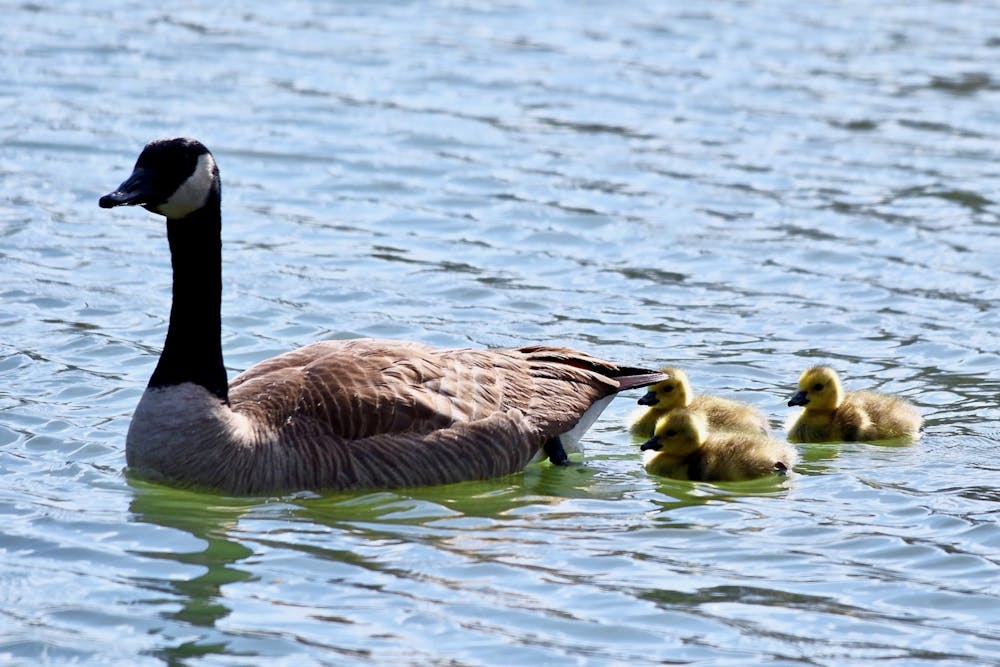It’s that time of year again: the first snow has fallen, the sun sets at 4:30, and Canada Goose jackets are filling Princeton’s campus.
The source of a lot of side-eyes and even memes, the Canada Goose jacket has somehow become a status symbol of the elite, and therefore, prevalent at Princeton. At the southernmost Ivy, where it has barely snowed twice the whole semester, it’s still almost guaranteed that you’ll see many of them hanging over seats in dining halls, libraries, and eating clubs. They are the subject of much debate between students — some shamelessly saving up for one of the coveted jackets, some ambivalent to the brand, others infuriated at the obscene show of wealth.
There seems to be no unified logic or argument about the jackets’ presence. In acknowledging the culture of wealth they perpetrate, are we supposed to attack our peers for owning them? Should students who can afford a $900-plus winter jacket feel ashamed? Does the fact that this issue is even a debate indicate how disconnected Princeton is from reality?
In asking all these questions, however, one crucial aspect is rarely considered. In terms of showcasing wealth, the ethics of a Canada Goose are debatable. In the normalization and glorification of killing animals for a certain brand, however, the ethical fallacies are indisputable.
As stated on the company’s own website, most Canada Goose jackets are filled with goose down, “one of the world’s best natural insulators,” and the hoods are lined with coyote fur to “help protect the face from frostbite.” The brand name itself comes from the use of animals to create what is marketed as the warmest winter jacket possible. The company insists that “all animals are entitled to humane treatment in life and death,” and they “are deeply committed to the ethical sourcing and responsible use of all animal materials in our products.”
When we look deeper into their actual procedures, however, the story changes. The blatantly cruel treatment of animals is deeply concerning. The coyote fur comes from trapping, which often involves leghold traps that leave animals caught for days, essentially starving them to death.
The goose down is not any better sourced. In 2017, People for the Ethical Treatment of Animals (PETA) sent investigators to James Valley Colony (JVC), one of Canada Goose’s down providers. The footage captured there shows tight, cramped cages and geese being moved and carried by their throats before being slaughtered for down. Canada Goose responded to the video, claiming while JVC was one of their suppliers, the geese shown were not used for their jackets. The company has since denied accusations of inhumane animal treatment but also decreased marketing that trumpets its allegedly ethical policies, removing statements that the coyotes only come from overpopulated areas and videos on “down traceability.”
Though horrible, animal abuse for the sake of fashion is not unheard of. Many products include leather, wool, fur, and down; it can seem unfair to criticize only a single brand, such as Canada Goose. It is undeniable that animal cruelty as a practice is a larger issue at hand. But even within the industry, Canada Goose stands out. Its main problem is the unequaled glorification of its jackets and their elite image without recognizing any of the serious ethical implications.

Some might say the jackets’ use can be justified if the animal products were acquired humanely or are necessary in incredibly harsh winter environments. But when Canada Goose cites “protect[ing] the face from frostbite” to justify using coyote fur, it is clear the jackets have no practical purpose in Princeton, N.J. The jackets have taken on a life larger than just their practical use; their exorbitant price and use as displays of wealth have been discussed as a social issue on campus and elsewhere. Canada Goose’s social presence and idolization as a brand promotes a culture of thoughtless consumerism that willingly exploits and abuses animals and the environment to promulgate an image of the elite.
As another winter passes, the debates about Canada Goose jackets, those emblems of Princeton’s disproportionate wealth, are bound to continue. But we must also question what goes into creating that image of wealth and what realities we, as students at an institution that claims to pursue ethical practices, are willing to ignore in service of brands and markets. Through exposing and understanding a significant brand that feeds into this cycle, we can begin having the discussions necessary to dismantle a system that often compromises ethics for displays of wealth.
Kate Lee is a first-year from Austin, Texas. She can be reached at k.lee@princeton.edu.









